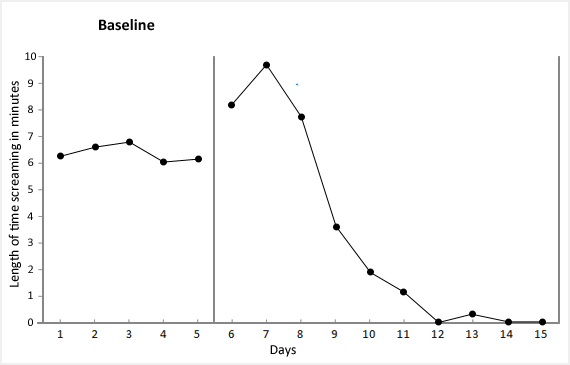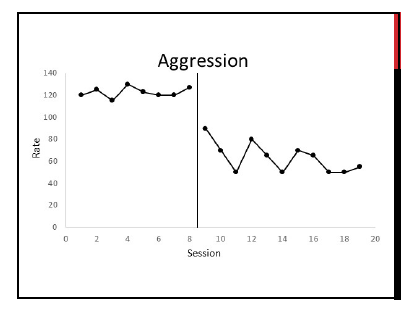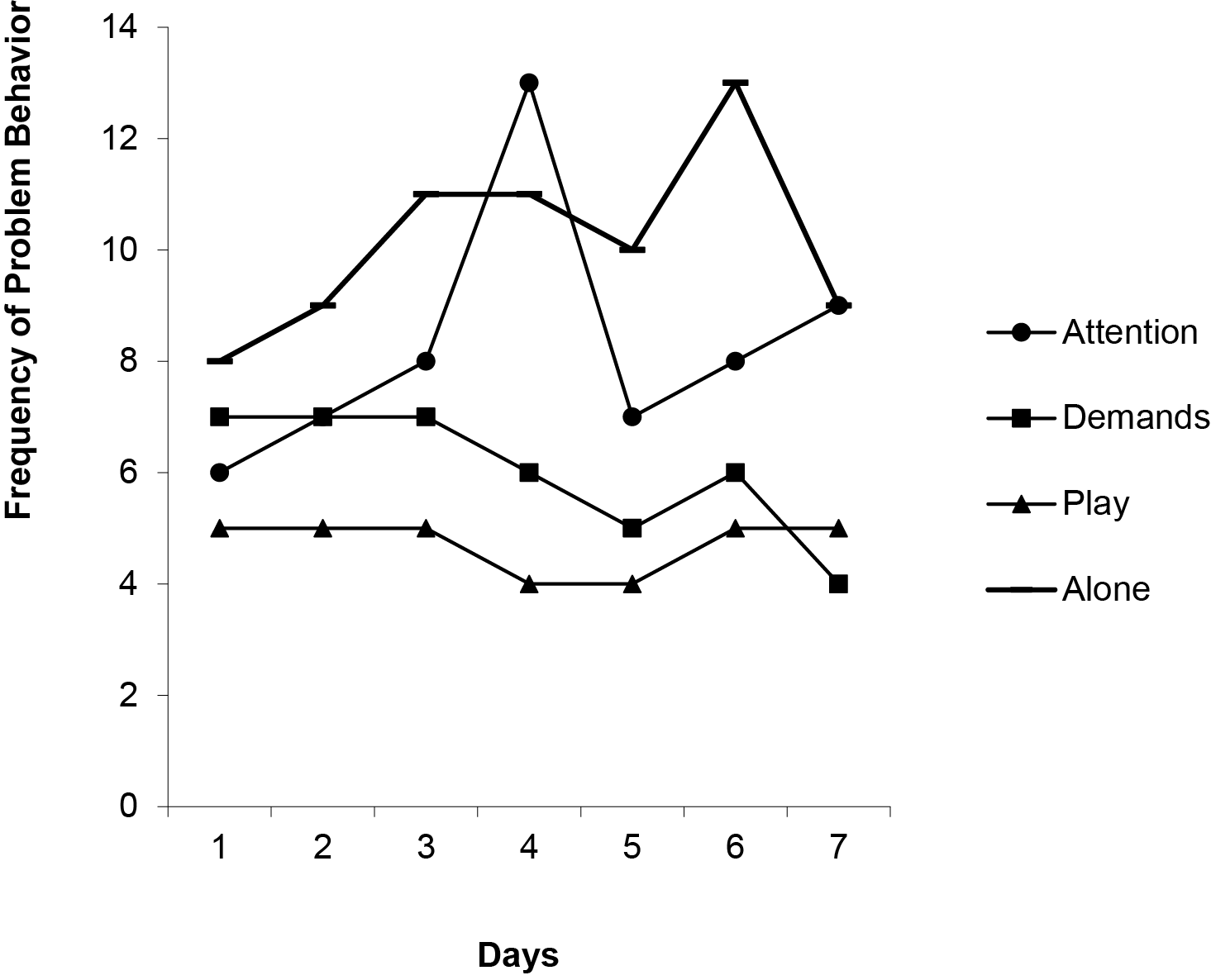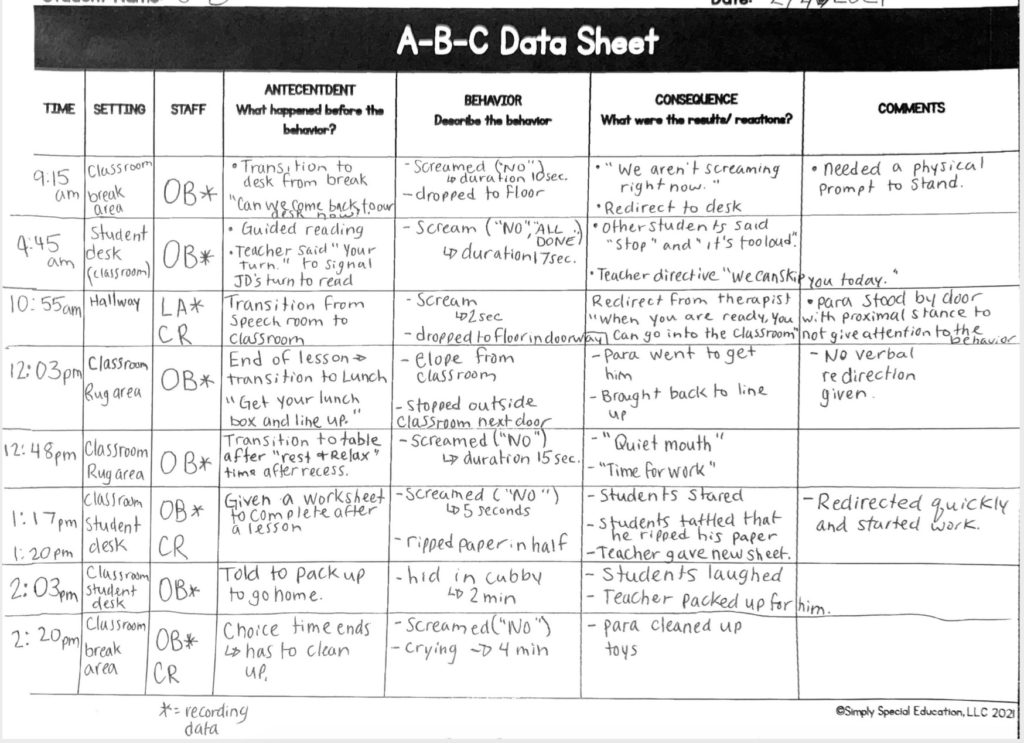These are referred to as the Dimensions of Applied Behavior Analysis
Behavioral, Analytic, Technological, Conceptually Systematic, Applied, Generality, Effective
What are the 5 main schedules of reinforcement.
Fixed interval, fixed ratio, variable interval, variable ratio, intermittent
This is the time between the same behavior.
Interresponse Time
This variable is commonly found in the results section of an ABA paper
Dependent Variable (DV)
in 2020, the BACB made a change to its gift-giving policy. This is the current amount BCBAs may now accept.
$10
These are the four functions of behavior.
Sensory, Access to Tangibles, Escape, Attention
This procedure involves reinforcing successive approximations towards a terminal behavior.
Shaping
To provide an intervention for a client, that intervention should be an _____________.
Evidence-Based Practice (EBP)
This theory of behavior is only concerned with the overt Stimulus-Response variables
Methodological Behaviorism
Extinction is...
withholding reinforcement from a behavior that was previously reinforced in an attempt to decrease the behavior. (Off the top of my head!)
Withholding reinforcement for a previously reinforced behavior to reduce its occurrence.
______ interval recording is commonly used when trying to increase behavior. _________ interval recording is commonly used to decrease behavior.
Whole, Partial
________ validity is the extent to which the study is reliable, based on the design, analysis and other factors. ________ validity is the extent to which the results are generalizable.
Internal; External
A client has recently begun hitting his head on walls and tables and has resulted in injury. What is your first course of action as a BCBA?
A. Conduct an FBA
B. Begin intervention immediately
C. Refer to determine if medical variables are present
D. Interview the parents to see if it is also happening at home
C. Refer to determine if medical variables are present
You need to conduct a preference assessment for your client. Your client is very mobile and loves to explore new toys. What assessment would you likely use?
Free operant assessment.
This procedure is commonly used as an antecedent strategy and is typically delivered on a timed schedule
Non-Contingent Reinforcement (NCR)
When decreasing behavior, we must also always find an __________ behavior to increase.
Alternative
This concept is thought to be the primary difference between Radical Behaviorists and Methodological Behaviorists
Private Events
This occurs when a behavior comes under the restricted control of an irrelevant
antecedent stimulus.
Faulty stimulus control
What type of procedure is likely being used here?

Extinction
Name two behaviors for which a withdrawal/reversal design would not be effective.
Reading/Literacy, Mathematics, Anything that once its learned cannot be unlearned (Riding a bike)
When faced with an ethical dilemma, behavior analysts may use this approach.
Ethical decision-making model
Your client frequently elopes from circle time. The teachers do not follow her and she typically begins to play with trains. The function of this behavior is likely ___________.
Access to Tangibles.
Timmy engaged in high rates of property destruction at school. After implementing an intervention, these rates have drastically reduced. However, his parents report that he has begun to destroy property at home. This is likely due to _______________.
Behavioral contrast.
Your client just mastered tacting the numbers 1-5 with the prompt "What number is it?" and using an FR1 schedule of reinforcement. What is the next logical step to work on?
A. Remove the prompt and just show the child the number.
B. Reduce the frequency of reinforcement and move to a VR schedule.
C. Use symmetry to teach receptively ID when you say a number between 1-5
D. Move on to numbers 6-10.
A or B are good answers!
Explain the domain of being "Conceptually Systematic"
Basing strategies of implementation upon existing behavior analytic principles.
You show a child a picture of your cat, and ask them to find that same picture in an array of 4 on the table, with no previous reinforcement being given or currently available. This is known as _____________.
Reflexivity
Describe the level, variability and trend of this graph.

Level - High levels in BL, moderate levels in intervention
Trend - No trend in either phase (maybe a slight decrease trend in intervention)
Variability - Stable rate of aggression in both phases
There are 8 of these threats to internal validity. Name 5 of them.
History, Maturation, Testing (Reactivity), Instrumentation, Drift, Attrition, Lack of Integrity of Experimental Conditions, Data Instability
These are the four Core Principles of the Ethics Code for Behavior Analysts.
1. Benefit Others
2. Behave with Integrity
3. Treat Others with Compassion, Dignity and Respect
4. Ensure their Competence
What is the likely function(s) of this challenging behavior? Provide context.

Primarily: Attention and Sensory.
Secondarily/Tertiary: Escape and Access to Tangibles
During school, Alan receives 10 minutes of iPad time when he completes his English homework during school. When he completes his English homework at home, he receives 1 hour of iPad time. Thus, he typically does his English homework at home. What is the concept that explains this?
Matching Law
This is "the match between the strategies, procedures, or elements of an intervention and the values, needs, skills, and resources available in a setting."
Contextual fit.
Referring to Baer, Wolf & Risley (1968), how is an intervention determined as being "Effective"?
Effectiveness is ultimately determined by those "who must deal with the behavior" (p. 96). The consumers ultimately determine how "effective" the intervention is.
Give examples of symmetry and transitivity.
Symmetry - without previous reinforcement, you speak the word "Car" and the child finds a car amongst his toys.
Transitivity - I teach finding a car when I say "Car" (A ->B) then teach finding the word "C-A-R" when a car is presented (B ->C) and now when I say "Car" the child can find the word "C-A-R" without having been previously reinforced.
+ 100 - What experimental design is being used here?
A1 - Low levels of Disruption, No trend, Mild/moderate variability
B1 - High levels, Trending upward, initially variable, stable now
A2 - Low levels, trending upward, mild variabilty
B2 - High/moderate levels, no trend, mild/moderate variability
Withdrawal/Reversal Design
There are critical components to completing single-case design. Name them (there are 8). For 100 points each, describe their function.
Functional Relation - The IV is responsible for the shift in the DV
Experimental Control - No clear threats to internal validity
Dependent Variable - Defined, measured over time, established functional relational
IOA - Ensuring accurate, valid measure of DV
Independent Variable - Defined, Variable manipulating the DV
Fidelity - Ensuring accurate, valid implementation of IV
External Validity - Generalizable
Social Validity - Are the goals, implementation and outcomes acceptable to the consumer.
The Ethics Code makes clear that behavior analysts must operate within their scope of competence. In order to demonstrate learning in a new area, BCBAs must _______ and _______ the appropriate study, training, supervised experience, consultation, and/or co-treatment from professionals competent in the new area.
1.05: They engage in professional activities in new areas (e.g., populations, procedures) only after accessing and documenting appropriate study, training, supervised experience, consultation, and/or co-treatment from professionals competent in the new area.
Based on this ABC Data Sheet, what is the likely function(s) of this screaming behavior?

Escape and Attention.
There are 5 methods of using differential reinforcement. List all 5 and give an example for 3 of them.
DRO - Interval schedule to reduce self-injury. Reinforcing the absence of SIB.
DRI - Reinforcing instances/intervals where child engages in the incompatible behavior and the challenging behavior is placed on extinction. Ex. Reinforcing instances when child wraps themselves in a scarf in a manner that prohbits them from engaging in SIB.
DRA - Reinforcing instances/intervals where child engages in the alternative behavior and the challenging behavior is placed on extinction. Ex. Child uses a "Break" card to escape work instead of destroying the assignment.
DRL - Reinforcing lower rates of behavior. Ex. Child who excessively watches hands before lunch - reducing the time to an appropriate level and placing previously reinforced times on extinction.
DRH - Reinforcing higher rates of behavior. Ex. Child who rarely raises their hand - reinforcing more instances of hand-raising to a more "appropriate" level.
Your client is not progressing on their hand washing goal, despite the family and school doing all procedures with fidelity. The client engages in no challenging behavior when hand washing, but is still requiring full physical prompting to complete the task after 2 months. What are two possible ways to shift this intervention?
Increase reinforcement
Reduce physical prompt dependence
Use stimulus prompts